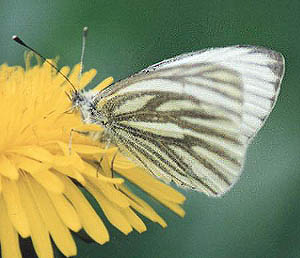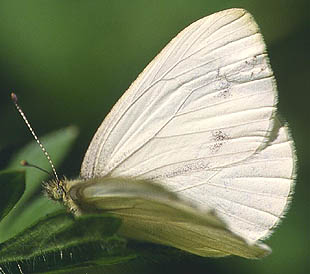
© Markku Savela
BUG OF THE MONTH: May 1996
Veined White Butterfly
formerly Pieris napi, now Pieris marginalis
Copyright © 1996 by Louise Kulzer
This article originally appeared in Scarabogram, May 1996, New Series No. 193, p. 2.
 |
| Pieris napi, specimen from Finland © Markku Savela |
The veined white is a butterfly of forested areas, especially near forest edges and clearings. I have found it more common in suburban areas, e.g. Redmond, than in the city; coincidentally, the suburbs are where the forest patches are.
The veined white looks superficially like a cabbage white. The dark dorsal wing spots are lacking (light dorsal sex spots are not uncommon), but the underside of the wing veins are often lined by dark scales (photo, right), giving them a bold, dramatic look. Later in the season, however, many individuals are lighter, and often lack vein lining altogether (that is, they are immaculate; see photo below).
All veined whites used to be known as Pieris napi (above right). Today, that name has been restricted to Old World populations; of the three very similar North American species, P. marginalis (below) is our local Puget Sound form.
The larvae feed on native crucifers such as Arabis and Barbarea, at least that's what Christensen says. I've never seen the caterpillars, so I can't verify this, but Arabis seems a bit of a dry side of the mountains plant to me, as does Barbarea. Perhaps lowland food plant observations are a bit scarce? Tilden (1965) reports that the caterpillars are green with three yellow stripes, one down the back and one on each side.
 |
| Pieris marginalis from western Washington © Markku Savela |
With the introduction of the cabbage white with which it may compete (authors disagree) and the widespread clearing of forests, the veined white is becoming less and less common. The next time you see a white flitting through, take a closer look to see if it is the usual cabbage white, or if it may be a veined white. And if you're walking through a local park or arboretum, by all means take your net along and check out the whites!
This species might be a good candidate for re-introduction to urban areas such as Discovery Park or Lincoln Park. If we knew the local food plants, any such management attempts would be more likely to succeed.
References
Christensen, James R. 1981. A field guide to the butterflies of the Pacific Northwest. University of Idaho Press, Moscow, Idaho.
Tilden, J.W. 1965. Butterflies of the San Francisco Bay Region. University of California Press, Berkeley and Los Angeles.
This page last updated 16 June, 2005